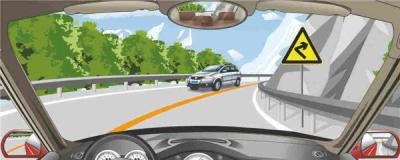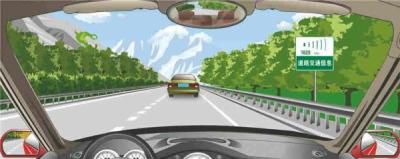1、What should the driver do when a motor vehicle encounters this situation on a mountain road?

A、Stick to respective lanes and speed up to approach each other
B、Drive close to the central line of the road
C、Retain the normal speed
D、Slow down
Answer:D
2、It is safest for a motor vehicle driver to overtake the vehicle in front from its righthand on this kind of road.

A、Right
B、Wrong
Answer:B
3、The sign on the right indicates a 2-kilometer distance from the Donglushan Service Area on the highway.

A、Right
B、Wrong
Answer:A
4、This sign indicates the traffic broadcast and radio television channel of highway.

A、Right
B、Wrong
Answer:B
5、The sign in front indicates the name and number of the highway.

A、Right
B、Wrong
Answer:A
6、The sign on the right indicates a one-kilometer distance from the ETC toll station.

A、Right
B、Wrong
Answer:A
7、The sign in front indicates that vehicles except public buses are not allowed to drive in this lane.

A、Right
B、Wrong
Answer:A
8、The guide arrow on the road surface of this lane indicates that only right turns are permitted at the intersection ahead.

A、Right
B、Wrong
Answer:B
9、When a vehicle encounters a strong side wind, the driver should firmly hold the steering wheel and press the brake urgently if he feels the vehicle deviates horizontally from the normal direction.
A、Right
B、Wrong
Answer:B
10、When a bicycle occupies the motor vehicle lane and obstructs the traffic, the driver should sound the horncontinuously and speed up to bypass on the left of the bicycle.
A、Right
B、Wrong
Answer:B
11、The sign on the right warns of no passing due to collapse on the road ahead.

A、Right
B、Wrong
Answer:B
12、The sign on the right side indicates no entry for all vehicles.

A、Right
B、Wrong
Answer:A
13、When approaching another vehicle at night, why should the driver alternate between high-and-low-beam at a distance more than 150 meters?
A、Warn each other before passing
B、Driving habit
C、Easy to observe the situation ahead from either side
D、Courtesy
Answer:C
14、When a motor vehicle passes over an inundated road, what should the driver do for safe driving?
A、Slow down and drive with special care
B、Speed up and pass rapidly
C、Maintain a normal speed and pass through
D、Change to a low gear and speed up to pass
Answer:A
15、What should the driver do when seeing these hand signals?

A、Turn left at the intersection
B、Stop and wait
C、Go straight at the intersection
D、Drive to the waiting area for turning left
Answer:B
16、When approaching a sharp curve, motor vehicle drivers should reduce speed only after entering the curve.
A、Right
B、Wrong
Answer:B
17、The road marker indicates that vehicles are not allowed to make a U-turn at the intersection ahead.

A、Right
B、Wrong
Answer:A
18、Motor vehicles on this kind of road are only allowed to overtake the vehicle in front from left.

A、Right
B、Wrong
Answer:A
19、What should the driver do in this situation?

A、Speed up and overtake from the left side
B、Sound the horn continuously to warn the bicycle
C、Follow the bicycle closely
D、Slow down and yield to the bicycle
Answer:D
20、What matters need attention when driving on a rainy day?
A、Avoid using the emergency brake or making sharp turns
B、Keep a safe enough distance
C、Observe the traffic situation of non-motor vehicles and surrounding pedestrians
D、Drive at a safe speed
Answer:ABCD
21、Motor vehicles are prohibited from driving straight or turning left in this situation.

A、Right
B、Wrong
Answer:A
22、After setting off from the roadside, motor vehicle drivers should speed up as soon as possible and make a sharp left-turn in order to drive into the normal lane.
A、Right
B、Wrong
Answer:B
23、When an erosive material catches fire, it should not be put out with water cannon.
A、Right
B、Wrong
Answer:A
24、When a motor vehicle equipped with ABS makes an emergency brake, the driver can tread the brake pedal heavily.
A、Right
B、Wrong
Answer:A
25、When the engine suddenly stalls on the road and cannot be restarted, the driver should pull over in a timely fashion and identify the cause of the stalling.
A、Right
B、Wrong
Answer:A